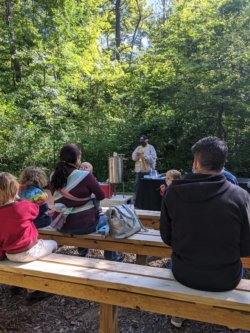 On September 19 and 20 we welcomed guests and their families to learn more about the amazing life of the honey bee. Over 200 attendees stopped at five different educational stations, first learning about the social life of bees with footage from beekeeper and photographer Fred Dunn.
On September 19 and 20 we welcomed guests and their families to learn more about the amazing life of the honey bee. Over 200 attendees stopped at five different educational stations, first learning about the social life of bees with footage from beekeeper and photographer Fred Dunn.
At the next stop, guests learned about pollination and why honey’s color varies greatly. The color is dependent upon what species of plants are around the hive. For example, clover produces a light color of honey and buckwheat creates a deep amber color.
Next, Charlie Schroeck, Asbury Wood’s Beekeeper, along with Robert (Bert) Howells, both from the Northwestern Pennsylvania Beekeepers Association, explained how to extract the sweet treat from the comb. In order to get to the honey, the wax seal is scraped off and collected. The open honey comb is then put in an extractor machine where honey is spun out of the comb. The process is quite fascinating!
At the final stop Lynn Urban and Priscilla Hamilton from the NWPA Beekeepers Association discussed equipment needed for keepers and their experience looking after their own hives. What’s neat is that Lynn got into beekeeping six years ago after attending an Asbury Woods beekeeping festival. He started out with one hive and now has 11.

"My favorite part of beekeeping is the unsolved science behind it. I’m always learning something new and exciting. I encourage anyone interested in beekeeping to learn as much as possible about them before actually getting them. There is some initial expense involved with equipment and the bees themselves which can result is disappointment if they are not properly prepared," said Urban.
Keep reading for opportunities to learn more about backyard beekeeping and ways to suppor our honey bee population.
1. Learn how to be a backyard beekeeper.
Bert Howells from the Northwestern Pennsylvania Beekeepers Association will lead this one-day workshop on October 3. Participants will walk away with the knowledge to start and manage their own hives.
2. Plant native species around your yard.
Attend our free Meadow Seed Collection Day to harvest seeds for native species that bees and other pollinators enjoy.
3. Buy local honey products.
Your purchase financially supports local beekeepers. Not only do they tend to the hive, but beekeepers are also environmental stewards. You can find local honey at our gift shop, which is open on Saturdays and Sundays from 12-5 p.m. in October. Lynn recommends adding it to your tea or drizzle it on your toast.
4. Rehome swarms on your property.
A swarm of bees can be intimidating. The swarming bees are looking for a new home and sometimes pick a house or school to relocate. Call a local beekeeper to remove the swarm. The beekeeper will be thrilled to take them off your hands and you no longer have a bee problem.
